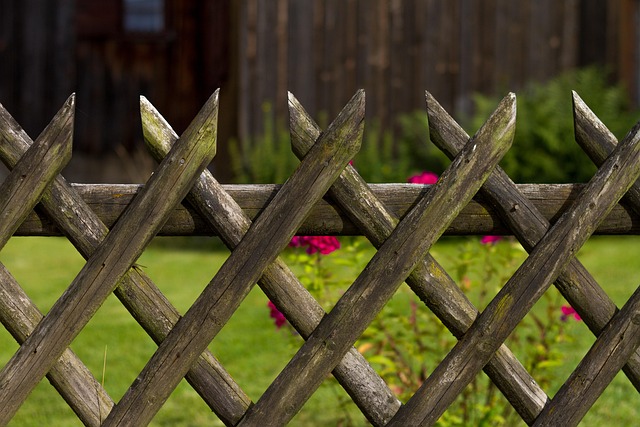Introducing Fence Staining and Sealing for Wooden Fences
Your wooden fence is more than just a boundary; it’s an exterior feature that enhances your home’s curb appeal. Proper staining and sealing are key to preserving its beauty and longevity. This comprehensive guide delves into the intricacies of fence staining, from understanding the benefits and exploring various types to mastering application techniques. We’ll also dissect the importance of sealing for protection and provide essential maintenance tips to ensure your wooden fence remains a striking focal point for years to come.
- Understanding Fence Staining: Benefits and Types
- Preparing Your Wooden Fence for Staining
- Choosing the Right Stain: Color and Formula
- Applying Stain: Techniques and Tips
- Sealing for Protection: Why and How
- Maintenance: Extending Life with Regular Care
Understanding Fence Staining: Benefits and Types
Fence staining is a popular method to enhance the appearance and protect wooden fences. It involves applying a pigmented sealer or paint to the fence’s surface, offering various benefits. First, it provides an aesthetic upgrade by allowing you to choose from a wide range of colors, ensuring your fence complements your home’s exterior. Staining also protects wood from elements like UV rays, moisture, and extreme temperatures, which can cause fading, cracking, and rotting. Over time, stained fences require less maintenance compared to unstained ones.
There are two primary types of fence staining: semi-transparent and solid. Semi-transparent stains allow some light penetration, preserving the wood’s natural look while still offering moderate protection. Solid colors, on the other hand, create a more dramatic change in appearance and provide superior defense against environmental factors. Each type has its advantages, catering to different preferences and needs, ensuring your fence stays looking fresh and vibrant for years.
Preparing Your Wooden Fence for Staining
Before applying any stain or sealer, preparing your wooden fence is a crucial step. Start by thoroughly cleaning the fence to remove any dirt, dust, and debris. Use a pressure washer or a stiff brush to ensure the surface is free from contaminants. This initial cleaning will help the stain adhere better and create an even finish.
Once cleaned, inspect the wood for any repairs needed. Fill in cracks, split boards, or loose nails to ensure the fence is structurally sound. Sanding the fence gently can also help smooth out any rough spots and create a smoother surface for staining. Make sure all tools and equipment used during preparation are clean to avoid transferring any unwanted substances onto the fence.
Choosing the Right Stain: Color and Formula
Choosing the right stain is an essential step in fencing maintenance. Start by evaluating your fence’s current color and condition to determine the best match. Consider both solid colors and specialized formulas designed to enhance grain patterns or protect against specific elements. Dark colors absorb more heat, offering better fade resistance, while lighter tones reflect sunlight, keeping the wood cooler.
Formulas vary from water-based to oil-based options, each with unique benefits. Water-based stains are easy to apply, quick-drying, and emit fewer odors, making them ideal for indoor projects or areas where scent is a concern. Oil-based stains, though taking longer to dry, offer superior protection against UV rays and moisture, ensuring longer-lasting results in outdoor settings prone to harsh weather conditions.
Applying Stain: Techniques and Tips
Applying stain to your wooden fence is an art that requires careful consideration and technique. Start by ensuring the wood is clean, dry, and free from any debris. Use a soft-bristled brush or cloth to apply the stain evenly in small sections, following the wood grain for optimal absorption. This method ensures consistent coverage, preventing splotchy or missed spots.
When staining, work in a well-ventilated area and wear protective gear. Allow each section to dry according to the product’s instructions before moving on. Be patient; multiple thin coats are better than one thick one, as this technique enhances the wood’s natural beauty without compromising its integrity.
Sealing for Protection: Why and How
Wooden fences are an investment, and proper care is essential to maintain their beauty and longevity. One of the most effective ways to protect your fence is through sealing. Sealing acts as a shield against the elements, preventing water, UV rays, and other contaminants from penetrating the wood. Over time, these substances can cause decay, warping, and fading, significantly reducing the fence’s lifespan.
Sealing provides a protective barrier, filling in pores and cracks to stop moisture absorption. It also enhances the fence’s natural color and finish, making it look new again. Regular sealing is a simple and cost-effective way to keep your wooden fence looking its best for years to come.
Maintenance: Extending Life with Regular Care
Regular maintenance is key to extending the life of your wooden fence. Staining and sealing should be done at least once a year, depending on exposure to elements like rain, sun, and wind. This protective layer not only enhances the aesthetics but also shields the wood from water damage, rot, and UV rays that can cause fading and cracking.
By maintaining your fence, you can avoid costly repairs or premature replacement. Keeping an eye on its condition, cleaning it regularly to remove dirt and debris, and reapplying stain or sealant as needed are simple yet effective ways to ensure your wooden fence remains strong and vibrant for years to come.
